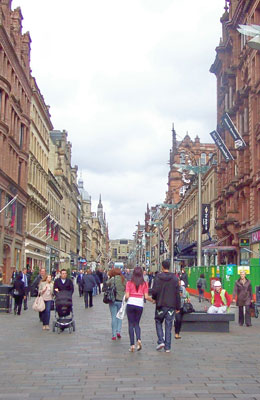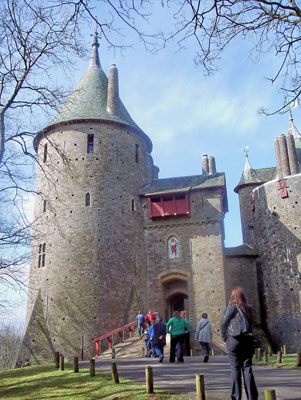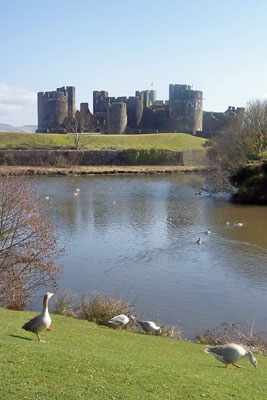Southern Wales with a Glasgow chaser
This item appears on page 60 of the November 2010 issue.
by Randy Keck (2 of 2 on the UK)
I spent three hectic days in London in March 2010 as part of a small press contingent being hosted by Visit Britain and Ireland. The next stage of our journey began as we departed the city by rail from Paddington Station bound westward to Cardiff, capital of Wales.
After a two-hour journey, we arrived in Cardiff and were immediately transferred to the waterfront for an extensive, behind-the-scenes tour of the state-of-the-art Millennium Centre, a truly world-class entertainment venue.
Music is a focal point of life in Wales, which touts a long line of famous international entertainers, including Shirley Bassey, Tom Jones and Catherine Zeta-Jones.
Celtic Manor
After only peripheral city touring, due to uncooperative weather, we departed for the Celtic Manor (Coldra Woods, The Usk Valley, Newport, South Wales, NP18 1HQ, U.K.; phone +44 [0] 1633 413 000 or, in the US, 866/789-5779 or, in Canada, 877/354-2003, www.celtic-manor.com), one of the UK’s top resort destinations.
With a 330-room, five-star hotel (double room, $180-$350), it has been open just over 10 years, and its Twenty Ten Course was built specifically to host the 2010 Ryder Cup golf championship.
In the evening, we fully enjoyed the tasting menu (£65, or about $102) at the resort’s multi-award-winning restaurant Crown at Celtic Manor.
The next morning, I had the opportunity to play the Twenty Ten (2010) Course, somehow negotiating the overwhelmingly difficult test of golf better than my purely duffer credentials should have allowed. Constructed in a valley, Twenty Ten was designed so that the final four holes have adjacent sloped hillsides, this to accommodate the massive throngs of visitors that were expected to attend the Ryder Cup in October.
Wales touring variety
Castles, a national park, a tiny whisky distillery, Welsh villages and a mine tour all were ingredients of our three-day whirlwind Wales itinerary.
Due to time and weather constraints, our time at scenic Brecon Beacons National Park was disappointingly limited. I recommend visiting between May and October.
Our second night in Wales was in the village of Abergavenny, only 20 miles from the border with England. We were accommodated at the unpretentious, pub-style, 32-room Angel Hotel (15 Cross St., Abergavenny, Monmouthshire, Wales NP7 5EN, U.K.; phone 01873 857121, www.angelhotelabergavenny.com). My room was comfortable, and the hotel’s fine, AA Rosette-rated restaurant lived up to its rating. Dinners run $18-$38.
Castles in the air
We were, unfortunately, limited to an exterior visit at the great, 13th-century, medieval Caerphilly Castle. At the time of its construction, it was considered a military masterpiece with its design of concentric defensive elements, including walls, guard towers and the large-scale use of moats. Caerphilly is the second-largest castle complex in Britain and one of the most photogenic.
Located in the heart of the busy city of Cardiff, Cardiff Castle was constructed and reconstructed many times, and close inspection of the castle structure and grounds reveals its episodic history. Its origins have been traced to the Normans in about 1081, and its ornately decorated living quarters are 19th century.
On the outskirts of Cardiff, we explored the smallish, ornate, lavish, fairy-tale Castell Coch. The current structure was built 1875-1891 on the ruins of the the original castle, which reportedly was founded by a Welsh lord between 1240 and 1265.
Fire in the pit
All members of our group were very impressed with our underground tour at the Big Pit: National Coal Museum in the town of Blaenafon, which, itself, is designated as a UNESCO World Heritage Site.
A highly educational walking tour of the old mine (closed in 1980) took us far below ground by elevator into the original caverns, revealing the ultraharsh, danger-laden realities of toiling in the mines. Once back on the surface, we visited the comprehensive on-site mining museum.
We barely scratched the surface of southern Wales’ myriad attractions on our brief visit, and the uncooperative weather had forced us to forgo a stop at the scenic Gower Peninsula.
On our train journey back to London, I shifted focus to my later flight, Heathrow to Glasgow, Scotland, and a touring visit with friends Sally and Hugh Sanders.
Glasgow invites
My Glasgow area touring with Sally began the following day with a visit to the southern end of Loch Lomond, where a cruise from Balloch provided an informative introduction to the history of the area.
Our expansive viewing stretched to the snow-covered peak of Ben Lomond in the north. Loch Lomond is the largest expanse of fresh water in Great Britain and is a gateway to the Highlands.
The next morning I took a 30-minute train journey from Cardross, where I was the guest of Sally and Hugh, up the River Clyde into Glasgow to do a city tour.
The train conveniently stopped at Queen Street Station just off historic George Square, first laid out in 1780, where I would begin my tour.
The double-decker tour bus does a hop-on/off narrated circuit around the city, with 21 stops. The ticket, available from the driver and valid for two days, is a good value at $14. My time allowed for doing the full circuit, one hour and 15 minutes, without disembarking.
Today Glasgow teems with redevelopment projects and remains a merchant city bustling with shops, pedestrian malls and a thriving cultural, nightlife and cuisine scene. Most of its primary visitor attractions can be accessed by the tour bus. Particularly noteworthy is the University of Glasgow campus on Gilmore Hill in the West End.
Glasgow on the hoof
After departing the tour bus back at George Square, my instinct was to simply engage in some unfettered pedestrian wandering, placing full trust in the process. Following the scent of money, I strolled along the fashionable Buchanan Street pedestrian mall hoping to get a feel for the city lifestyle in the brief time at hand.
One of my finds, the Whittard of Chelsea tea shop at 95 Buchanan Street, provided the chance to sample fine teas and chat with some amenable locals, who assisted with my Glasgow tutorial.
As I traversed the pedestrian-friendly city center, I marveled at the architecture, finally stopping to enjoy a bowl of hearty seafood stew at a nondescript local pub.
The day disappeared quickly, as is often the case when the learning curve is in pure ascent, and soon it was time to reboard the train back to Cardross for my final evening in the UK, to be enjoyed in the company of friends.
For information, brochures and maps for the UK, contact Visit Britain (800/462-2748, www.visitbritain.com).



